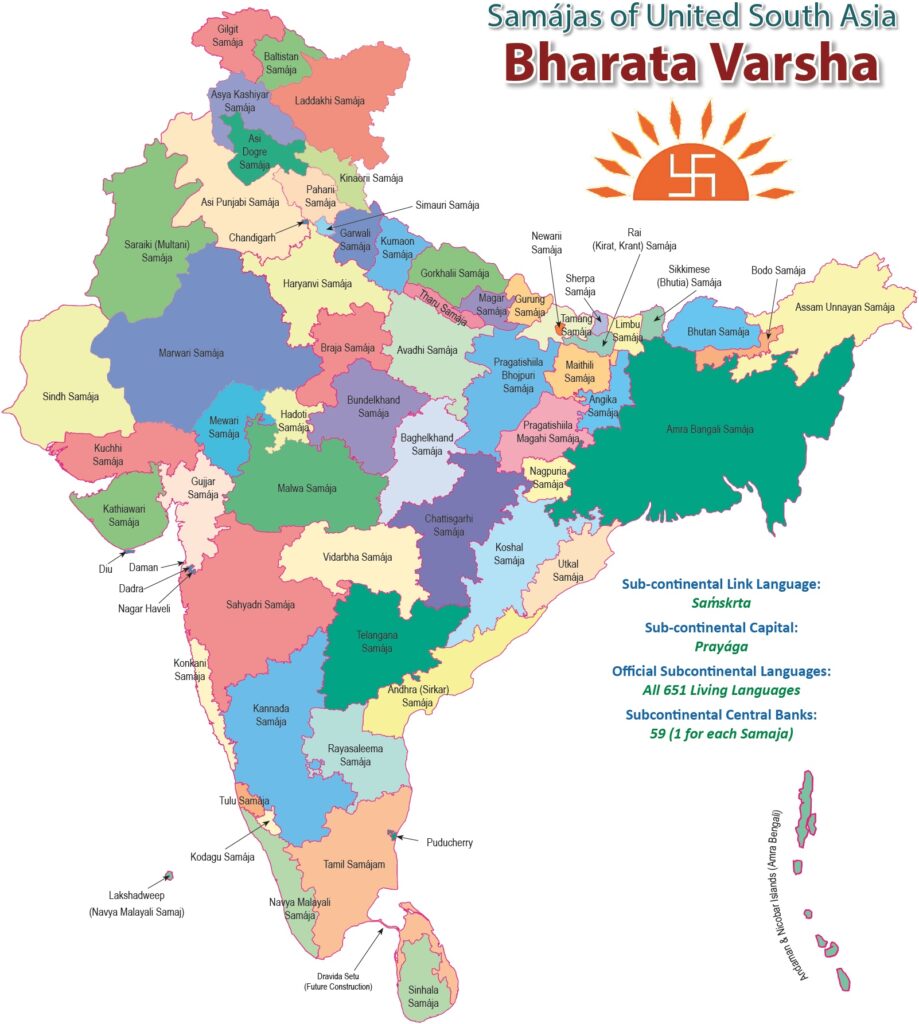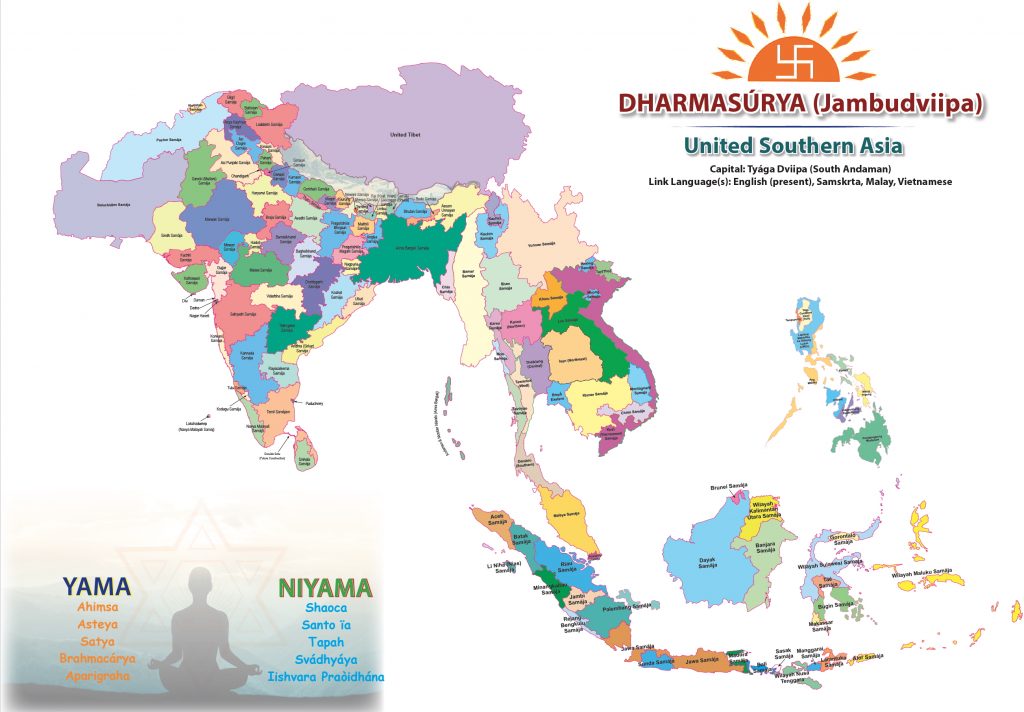
Samajas of Central South Asia
Click respective samája for detailed map
- Amra’ Banga’lii Sama’ja
- Angika Sama’ja
- Maethilii Sama’j
- Pragatishiila Magahii Sama’ja
- Pragatishiila Bhojpurii Sama’ja
- Na’gpuriya’ Sama’ja
- Utkal Sama’ja
- Koshal Sama’ja
- Bodo Sama’ja
- Assa’m Unnayan Sama’ja
- Avadhii Sama’ja
- Braja Sama’ja
- Hariya’nvii Sama’ja
- Gar’hwa’lii/ Gar’hva’lii Sama’ja
- Kuma’yunii Sama’ja
- Asi Punja’bii Sama’ja
- Sirmaorii Sama’ja
- Pahar’ii Sama’ja
- Kinaorii Sama’ja
- Asi Dogre Sama’ja
- Asya Kashiyar Sama’ja
- Laddakhii Sama’ja
KaJaHiL Rájya (province) - Ma’rva’r’ii Sama’ja
- Had’aotii Sama’ja
- Mewa’r’ii/ Meva’r’ii Sama’ja
- Kacchi Sama’ja
- Kat’hiya’va’rii Sama’ja
- Gujar Sama’ja
- Vidarbha Sama’ja
- Sahyadri Sama’ja
- Ma’lwa’/Ma’lwa’ Sama’ja
- Bundelkhan’d’ii Sama’ja
- Baghelkhan’d’ii Sama’ja
- Chattisgar’hii Sama’ja
- Telanga’na’ Sama’ja
- A’ndhra’/Sirka’r Sama’ja
- Ra’yal Siima’ Sama’ja
- Tamil Samajam
- Navya Malaya’lii Sama’ja
- Kannad’a Sama’ja
- Tulu Sama’ja
- Konkani Sama’ja
- Kod’a’gu’ Sama’ja
- Bhutia/Sikkimese Samaja
Other areas of Northeast India: Manipuri, Naga, Mizoram. Through service and friendship (not through force), these three areas may become part of Bangalistan when it is formed.
Samajas of Western South Asia
Samajas of Northern South Asia
- Bhuta’n Sama’ja
- Gorkhalii Sama’ja
- Newa’rii Sama’ja
- Ra’i Sama’ja
- Tha’ru’ Sama’ja
- Gurun’g Sama’ja
- Sherpa’ Sama’ja
- Magar Sama’ja
- Limbu Sama’ja
- Ta’ma’ng Sama’ja
Samajas of Southern South Asia
Provincial (State) Maps
Neighbouring Samajas in Other Regions
United Tibet Samaj
Baluchistan Samaj
Pastun Samaj
Nuristan Samaj
Asian Maps
1) Dharmsúrya (Jambudviipa) – United Southern Asia
2) Samyukta Ashiyá – United Asia


i want to know name of 256 samaj of world
The map has lot of problem and favour bengal. This is bangalaivad. Bycoot this map. Editor is influence by bengalivad.
Ragmarh is maghi how it is in bengalistan..
Editor should put ramgarh on maghi other
Pls reply soon
50% area of deoghar is I’m magadh
Pease see previous reply on Deoghar. Here is what Shrii Sarkar says about Deoghar. It was part of Birbhum district of Bengal and thus part of Rarh. You can meet many Bengalis who are old residents of Deoghar and who consider Birbhum as their homeland. In Discourse 7 of Varna Vijinana and Discourse 24 of the Rarh book, Shrii Sarkar clearly says the Rarh dialect of Bengali is spoken in Deoghar. Please see the quotes below. If you wish you may discuss further with Ac. Keshavanandaji who is born in Magadha and heard everything from Shrii Sarkar (Baba).
“Birbhum district was formed in 1856 by combining Suri, Rampurhat, Dumka and Deoghar, and certain portions of Murshidabad district.” (Some Developmental Programmes for Bengal, Proutist Economics)
“In Dhanbad, Deoghar, Dumka, Pakur, Godda, Birbhum and other places in Ráŕh, words which originated from Sanskrit are used extensively.” (Economic Self-Sufficiency for Bengal)
“Next to Birbhum is Gopabhum, which comprises Suri subdivision, Dumka subdivision, and Deoghar subdivision. The Sadgops with the surname of Ghosh used to be the rulers in this area, hence it was called Gopabhum.” (The History of Ráŕh)
“The Gopabhum kingdom consisted of Deoghar and Dumka Subdivisions of the district of Santal Pargana and Shiuri Sadar Subdivision of Birbhum. This entire kingdom was included in the Zilla [district] Birbhum during the Mughal period. The Sadgope kings, whose surname was Ghosh, ruled the land. Ichai Ghosh was the most notable of all the kings of the Ghosh dynasty. Most probably it was Ichai Ghosh who for the first time used Bengali in place of Sanskrit for the administrative work. It was Ichai Ghosh who brought a good number of Brahmans and Kayasthas to his kingdom, settled them on tax-free land, and planned to build a society of scholars. The Brahmans came from Burdwan and the Kayasthas from Kandi. A somewhat similar thing happened in Chut́iyá Nagpur (it is erroneous to call it Chota Nagpur). King Ratu of Ranchi brought a large number of Ráŕhii Brahmans from Burdwan and settled them there, in his own kingdom. In Ranchi District they are now known as Deoghariiya Brahmans [Brahmans of Deoghar origin – Deoghar was within Burdwan District at the time of their arrival]. It was these Deoghariiya Brahmans who established the Paoráńika cult in the Silli, Tamarh and Bagmundi regions. Afterwards, when Santhal Pargana was created, Dumka and Deoghar Subdivision were included in that newly-created district.” (Ráŕh – 30. History of the Regions of Ráŕh)
Here Shrii Sarkar mentions about the Deoghar, Godda and other areas as Bengali areas. Of course Eastern Godda is Angika:
“The mountain-folk who reside in the forests and remote mountains do not speak the exact same Bengali that the people from the plains of Godda Subdivision speak. Their Bengali is nearly a thousand years old because they have been living in inaccessible mountain areas. Since they have not maintained adjustment with the speed of the modern age, their language has undergone very little alteration in these one thousand years (hánu pánŕi khámu, hánu gharke jámu [I shall drink water, I shall go home]). However the conversation of residents of the plains in that area is similar to the spoken language of Birbhum. Conversely, the spoken language of the mountain-folk of the Sahebganj and Rajmahal regions is similar to that of Godda. The Malpaharis of the Deoghar, Jamtara, Dumka and Pakur areas remain closer to the people of the plains despite living in the forests and mountains; thus their spoken language shows some modern influences. The spoken language of the Malpaharis who live in the plains regions of eastern Rarh is similar to the spoken language of other local Bengalees. In the plains they are known as Jhalla-Mallas or Malla-Kśatriyas or Málos.” (Discourse 11, Varna Vijinana)
Manipur and other part of north east become
Bangalisthan without consult with thease people. I think is conspiracy.
Regard
Roshan
This inclusion of the Northeast in Bangalistan is a long term policy given by Shrii P.R. Sarkar during reporting. First the Bengali speaking areas of Assam (as indicated in his books) are to be included. Then areas in Nepal and Myanmar. Then other areas in the Northeast India can be encouraged to join.
Just as Sanskrit was proposed by Shrii Sarkar as the national language although many people in India (especially Tamil Nadu) do not accept it, similar is the case with Bangalistan existing as a multicultural, multi-linguistic samaja. Regarding the adivasi people, you may know that Shrii Sarkar clearly said that the Adivasis of Bengal are Adi Bangalis. This is known to non-Bengali persons as well such as Ac. Keshavanandaji (who used to be his PA) as well. It is not a conspiracy but a plan to unite all these areas.
As Shrii Sarkar said,
“Amongst the different ethnic groups of the northeastern region of India, an atmosphere of cordiality and fraternity has to be developed. Amongst the Bangali Hindus and Bangali Muslims, cordial ties must also be well-established. All kinds of social, economic, cultural and educational activities must be accelerated. This work should continue with a lot of intelligence and tact. Movements and agitations against the exploitation and deprivation of the local people must be launched immediately, and the Bengali speaking areas must be brought within the purview of the Bangalistan movement. The future of the entire northeastern region of India is very bright.” (Northeastern India)
Also please note in Histories Along the Way, Shrii Sarkar said Arunachal Pradesh is part of Assam, so Assam has also become much bigger, not just Bengal. Ultimately we have to research, talk to the people who were there with Shrii Sarkar and research the history and learn from the people there with an open mind and a heart full of love for all the people, languages and cultures in this beautiful land.
Few blocks of bokaro in maghi samaj.
Bokaro was part of Manbhum state in 1947. Bokaro and rest of Manbhum and Singhbhum fought to become part of Bengal.
But in the end only a small part of Manbhum was included in Bengal and re-named as Purulia District. Please see what Shrii P.R. Sarkar says in his books about Bokaro.
In this map deogarh is mention in amara bengali samaj.
But deogarh is divided in maghi, angika and amara bengali samaj. Pls correct. Reply soon.
Please see Chapter 30 of Shrii P.R. Sarkar’s book on Rarh and other discourses; you will find that entire Deoghar
is included in Amra Bangali. Some say Shrii Sarkar may have mentioned that west of the temple road in Deoghar town is Angika. Deoghar is not said by anyone as being related to Magadh. We have to go by what is written in Shrii Sarkar’s books.
But there is always scope for more discussion and changes in the maps. Concrete evidence is needed.
Karera is a part of Shivpuri district. The Karera depicted in the map of Bundelkhand society is a tehsil of Shivpuri district. Apart from this, Kolaras Badarwas Pichor Khaniyadhana tehsil also comes in Bundelkhand society, so it is appropriate to call it part of Shivpuri district.
Shivpuri is a border region between Bundelkhand Samaj and Braja Samaja. Perhaps if you talk to people of the area they will say both languages are spoken in Shivpuri. Regarding the exact division of this district, what is there on the two maps can be corrected after more research if needed. – Editors
District Shivpuri is divided into five subdivisions. Pohari, Karera, Pichore, Shivpuri, Kolaras. In the above map of Bundelkhand society, which is shown in the name of Karera, Kolaras and Pichore are included in the subdivision map, so it is necessary to mark them in separate maps. Similarly, the Shivpuri which has been marked in Brij Samaj includes Pohri subdivision. And in Braj Samaj, Sheopur district is shown while Hadoti language is spoken in half of Sheopur district. And in the half part which is adjacent to Morena, there is the influence of Brajbhasha. This improvement should be considered.
I want be informed regarding the regular development in this project and also want remain in touch on the project. And also advise me as to how I can contribute from my area Dimapur, Nagaland in this respect.
Namaskar.. This information is really very important for the Proutists. Thanks